Site WW13
Location: Lillimur
Australian Soil Classification: Calcic, Mottled-Mesonatric, Grey SODOSOL
Northcote Factual Key: Dg4.43
Great Soil Group: solodised solonetz
General Landscape Description: This soil occurs on the mid to lower slope of the gently undulating plains, gently undulating plains (closer spaced undulations) and undulating rises (closer spaced undulations) land units of the Yellow Gum Plains and Rises group. This soil is similar to WW12 that has been used to represent these land units. This site is located on a roadside reserve area, hence the organic accumulation at the soil surface.
 Site WW13 Landscape |
Soil Profile Morphology:
Surface Soil
| AO | 0-3 cm | Organic layer: | 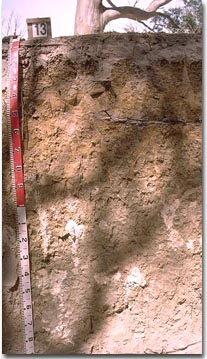 Site WW13 Profile |
| A1 | 3-10 cm | Brown (7.5YR4/2) loamy sand; weakly structured; pH 6.6: | |
| A2 | 10-20 cm | Pink (7.5YR7/4) sand; structureless; pH 6.3: | |
| Subsoil | |||
| B21 | 20-40 cm | Very pale brown (10YR7/3) medium heavy clay; many distinct brownish yellow mottles; coarse columnar structure (peds >200 mm), parting to strong polyhedral structure (peds 10-20 mm) and moderate polyhedral structure (peds 5-10 mm); clay skins; dispersive when worked; pH 5.8: | |
| B22 | 40-70 cm | Brownish yellow (10YR6/8) sandy clay; completely dispersive; pH 7.2: | |
| B23 | 70-90 cm | Pale yellow (2.5Y7/4) medium heavy clay (sandy); a few faint brownish yellow mottles; moderate prismatic structure (peds 20-100 mm), parting to strong blocky structure (peds 20-50 mm); a few manganese flecks; completely dispersive; pH 8.5: | |
| B24k | 90-150 cm | Light grey (2.5Y7/2) medium heavy clay (sandy); moderate prismatic structure (peds 50-100 mm), parting to strong blocky structure (peds 20-50 mm); soft calcium carbonate segregations are common, with a few hard calcium carbonate nodules occurring in patches; pH 9.6: | |
| B25 | 150-200 cm+ | Light grey (2.5Y7/2) medium clay (sandy); moderate polyhedral structure (peds 20-50 mm), parting to strong polyhedral structure (peds 10-20mm); pH 9.0. | |
Horizon | pH | Salinity | Internal Drainage | Hydro-phobicity | ||
Surface (A1 horizon) | slightly acid | low | non-sodic | - | - | moderate |
Subsoil (B21 horizon) | moderately acid | low | strongly sodic | nil1 | imperfectly drained2 | - |
Deeper subsoil (at 1 metre) | extremely alkaline | medium-high | strongly sodic | moderate | - | - |
2 Most impeding horizon of the profile that will affect plant growth.
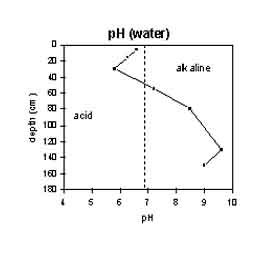 | 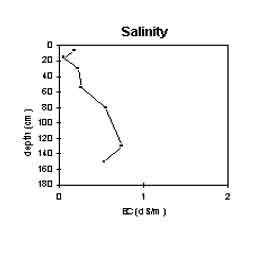 |
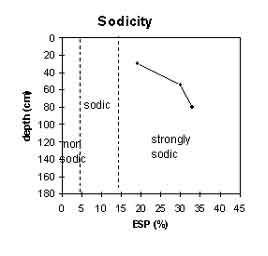 | 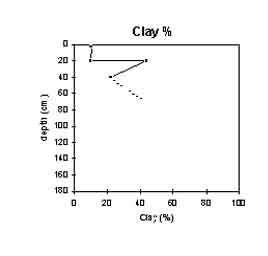 |
Key Profile Features:
- Sandy surface soil.
- Hydrophobic surface soil.
- Strong textural contrast between surface soil and subsoil.
- Bleached A2 capping over large hardsetting clay columns.
- Acidic surface soil.
- Top of the subsoil is dispersive following cultivation when wet.
- Clay skins on the B21 horizon repel water.
- Sodic subsoil.
- Columnar structure.
- Subsoil mottling.
- Alkaline subsoil.
Feature | Result | Management Prescription |
| Sandy surface soil. |
| Dryland cropping.
|
| Hydrophobic surface soil. |
|
|
| Acidic surface soil. |
|
|
| Bleached A2 horizon. |
| Dryland cropping.
|
| Strong textural contrast between surface soil and subsoil (duplex). |
|
|
| Sodic clay subsoil. |
|
|
| Columnar or prismatic subsoil structure. |
|
|
| Mottled subsoil. |
|
|
| Dispersion when reworked. |
|
|
| Alkaline subsoil. |
|
|
LAND USE | SUITABILITY CLASS | MAJOR LIMITING COMPONENT |
| Wheat | 2 | Climate, landscape, soil |
| Canola | 2 | Climate, landscape, soil |
| Chickpeas | 3 | Soil |
| Lentils | 3 | Soil |
| White clover seed | 2 | Landscape, soil |
| Lucerne for seed production | 3 | Soil |
| Viticulture | 3 | Soil |
| Apples | 2 | Climate, soil |
| Potatoes | 3 | Soil |
| Carrots | 3 | Soil |
| Onions | 3 | Soil |
| Sweet corn | 3 | Soil |
| Radiata Pine | 3 | Climate |
| Blue Gum | 3 | Climate |
| Wheat | Climate | 2 | Moderate frost risk, slightly high rainfall. |
| Landscape | 2 | Wind erosion hazard. | |
| Soil | 2 | Slightly impeded internal drainage, hydrophobicity. | |
| Canola | Climate | 2 | Moderate frost risk. |
| Landscape | 2 | Wind erosion hazard. | |
| Soil | 2 | Slightly impeded internal drainage, hydrophobicity, slightly acid subsoil pH. | |
| Chickpeas | Climate | 2* | Moderate frost risk, moderate to high rainfall. |
| Landscape | 2 | Wind erosion hazard. | |
| Soil | 3 | Sandy surface soil, impeded internal drainage. | |
| Lentils | Climate | 2 | Moderate frost risk, slightly high rainfall. |
| Landscape | 2 | Wind erosion hazard. | |
| Soil | 3 | Sandy surface soil, impeded internal drainage. | |
| White clover seed | Climate | 1 | No major limitation. |
| Landscape | 2 | Wind erosion hazard. | |
| Soil | 2 | Sandy surface soil texture, soil salinity, slightly impeded internal drainage, hydrophobicity. | |
| Lucerne for seed production | Climate | 1 | No major limitation. |
| Landscape | 2 | Wind erosion hazard. | |
| Soil | 3 | Impeded internal drainage. | |
| Viticulture | Climate | 2 | Moderate frost risk. |
| Landscape | 1 | No major limitation. | |
| Soil | 3 | Impeded internal drainage. | |
| Apples | Climate | 2 | Moderate frost risk, slightly high mean maximum January temperature. |
| Landscape | 1 | No major limitation. | |
| Soil | 2 | Depth of surface soil, slightly acidic pH, soil salinity, slightly impeded internal drainage, hydrophobicity. | |
| Potatoes | Climate | 2 | Slightly high mean maximum January temperature. |
| Landscape | 2 | Wind erosion hazard. | |
| Soil | 3 | Shallow depth of surface soil, impeded internal drainage. | |
| Carrots | Climate | 1 | No major limitation. |
| Landscape | 2 | Wind erosion hazard. | |
| Soil | 3 | Shallow depth of surface soil, impeded internal drainage, soil salinity. | |
| Onions | Climate | 2 | Moderate frost risk. |
| Landscape | 2 | Wind erosion hazard. | |
| Soil | 3 | Impeded internal drainage. | |
| Sweet corn | Climate | 2 | Slightly low mean monthly temperature (October - March). |
| Landscape | 2 | Wind erosion hazard. | |
| Soil | 3 | Shallow depth of surface soil, impeded internal drainage. | |
| Radiata Pine | Climate | 3 | Low rainfall. |
| Landscape | 2 | Wind erosion hazard. | |
| Soil | 2 | Slightly impeded internal drainage, hydrophobicity. | |
| Blue Gum | Climate | 3 | Low rainfall. |
| Landscape | 2 | Wind erosion hazard. | |
| Soil | 2 | Slightly impeded internal drainage, hydrophobicity. |
* Some areas may be higher rainfall.
Profile Described By: Mark Imhof, Nathalie Baxter (08/01/97).


